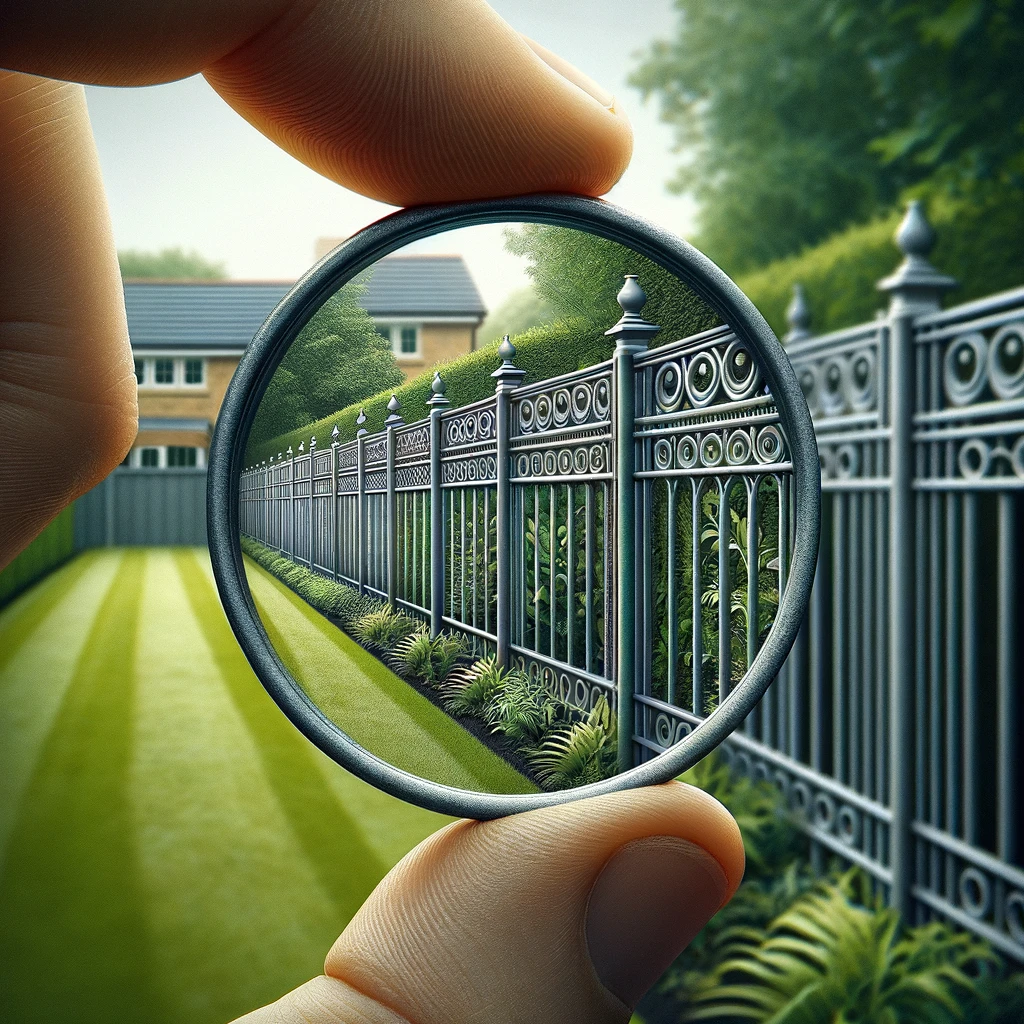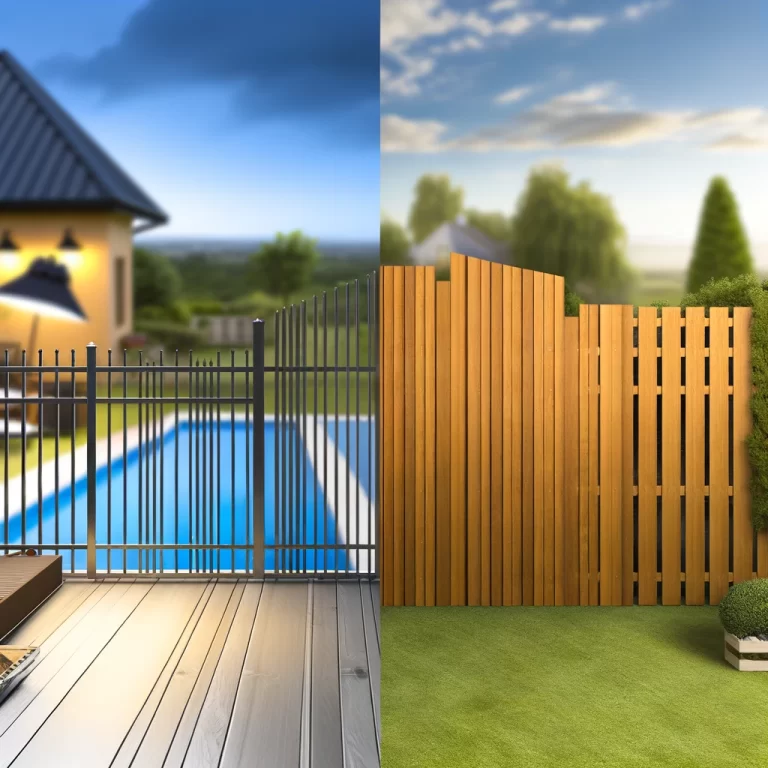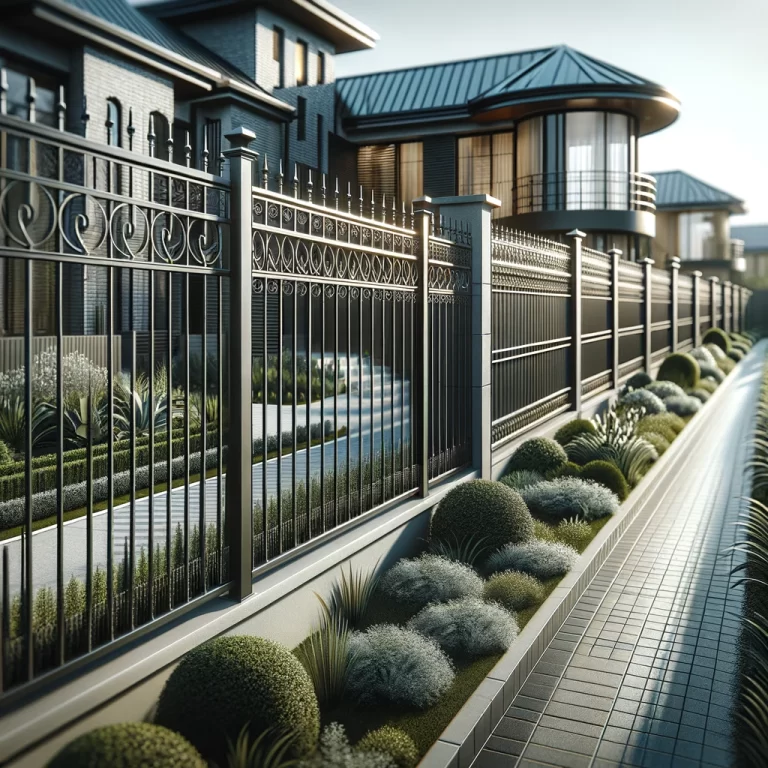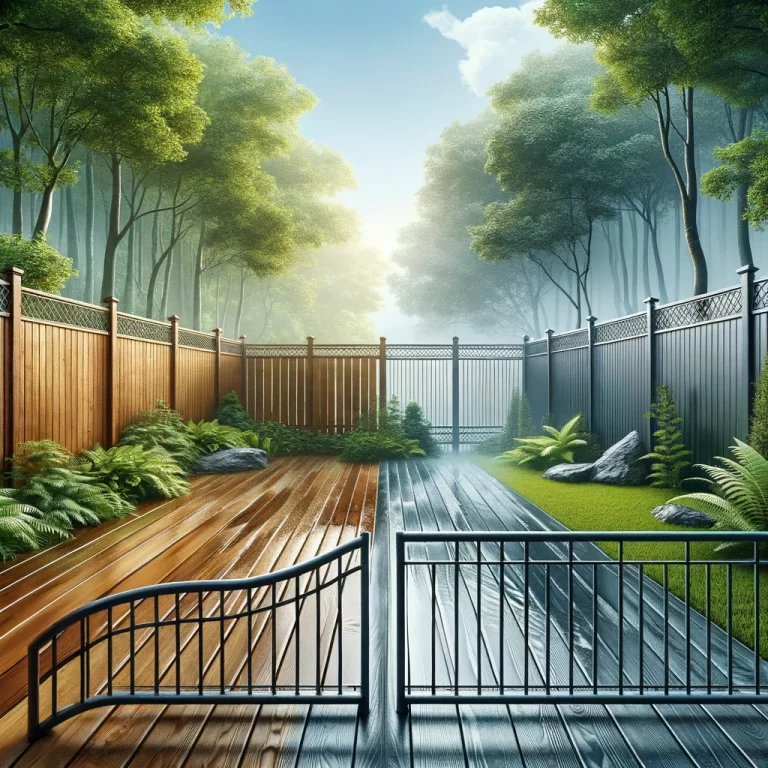Metal fences are a popular choice for homeowners looking to enhance their property’s security and aesthetics. With various types such as wrought iron, aluminium, steel, and chain link fences available, it can be overwhelming to choose the right one. Factors like material cost, labour cost, and design can affect the price of metal fences. Despite their higher cost compared to other types of fences, metal fences offer durability, low maintenance, and customisation options that make them worth the investment. Want to learn how to save money on metal fences? Read on to find out more.

What Are Metal Fences?
Metal fences, including wrought-iron, aluminium, and steel options, are popular choices for property boundaries due to their durability, security features, and aesthetic appeal.
Wrought-iron fences are known for their classic and elegant look, making them ideal for historic homes or properties seeking a traditional feel. They are strong and sturdy, providing excellent security and standing up well to harsh weather conditions.
Aluminium fences, on the other hand, are lightweight yet durable, offering a maintenance-free option that doesn’t rust or corrode. They come in a variety of styles and colours, suitable for both residential and commercial properties.
Steel fences, being incredibly strong and versatile, are often chosen for high-security applications such as industrial facilities or government buildings. They can be customised to fit specific design needs and are highly resistant to impacts and forced entry.
While each type of metal fence has its own unique characteristics, all provide long-term value and enhance the overall kerb appeal of the property.
What Are The Different Types Of Metal Fences?
Metal fences come in various types, such as wrought iron, aluminium, steel, and chain link options, each offering distinct features and design aesthetics.
Wrought Iron Fences
Wrought iron fences, crafted by skilled blacksmiths, offer a timeless and elegant design that enhances the aesthetic appeal of any property while providing security and durability.
The artistry and craftsmanship involved in creating wrought iron fences are truly remarkable. These fences are meticulously crafted, often featuring intricate designs and patterns that showcase the skill and creativity of the artisans. Customisation options abound, allowing property owners to tailor the fence to their specific style and needs. From traditional scrolls and finials to more modern geometric patterns, wrought iron fences offer a wide range of ornamental features to choose from.
Aluminium Fences
Aluminium fences, known for their lightweight and low-maintenance properties, are a popular choice among homeowners seeking a cost-effective and stylish fencing solution.
One of the key advantages of aluminium fencing is easy installation, which makes it a feasible option for those looking to embark on a DIY project. According to HomeAdvisor recommendations, aluminium fences are not only durable but also offer excellent weather resistance, making them suitable for various climates. Homeowners can enjoy the flexibility of customisable designs with aluminium fences, allowing them to tailor the look of their outdoor space to suit their preferences.
Steel Fences
Steel fences, known for their strength and durability, are ideal for properties requiring enhanced security and long-lasting fencing solutions that withstand environmental elements.
Typically crafted from galvanised steel or wrought iron, these fences offer a classic yet modern aesthetic, adding value to residential and commercial properties alike. The robust construction of steel fences ensures they can endure harsh weather conditions, resisting rust and corrosion over time.
Installation of steel fences is a meticulous process, often involving skilled labour due to the heavy and sturdy nature of the material. Maintenance of steel fences primarily involves periodic inspections for any signs of wear, repainting if needed, and ensuring the security features are intact.
Chain Link Fences
Chain link fences, recognised for their affordability and practicality, are commonly used in residential and commercial settings for boundary demarcation and security purposes.
One of the key advantages of chain link fences is their ease of installation. With their simple design and straightforward assembly process, they can be implemented quickly and efficiently by professionals or even experienced DIY enthusiasts. This not only saves time but also reduces labour costs for property owners. These fences are known for their cost-effectiveness, making them a budget-friendly option for individuals looking to secure their properties without breaking the bank.
What Factors Affect The Price Of Metal Fences?
The price of metal fences is influenced by various factors, including material costs, labour expenses, design choices, and the level of security or privacy desired for the property.
Material Cost
The material cost plays a significant role in determining the overall price of a metal fence, with wrought-iron and ornamental options typically being more expensive than aluminium or steel alternatives.
Wrought iron, known for its durability and elegance, exudes a timeless charm but comes at a higher price due to its production complexity and higher material expenses.
On the other hand, aluminium, offering lightweight properties and resistance to corrosion, presents a cost-effective solution for those looking to achieve a sleek and modern aesthetic without breaking the bank.
Steel strikes a balance between affordability and strength, making it a popular choice for those seeking a middle-ground option that doesn’t compromise on quality.
Labour Cost
Labour costs for metal fence installation can vary based on the complexity of the design, the size of the property, and the expertise required for proper fence assembly.
When assessing the intricacy of the fence design, factors such as ornamental details, decorative elements, and customised features can significantly impact the labour costs. The dimensions of the property play a crucial role, as larger areas may require more materials and installation time, consequently affecting the overall expenses. Skilled labour demands, including welding abilities, precise measurements, and knowledge of material properties, also contribute to the total cost of the project by influencing efficiency and workmanship.
Fence Height and Length
The height and length of a metal fence impact both the installation complexity and material requirements, thereby influencing the overall costs associated with the fencing project.
When considering fence customisation, taller and longer fences not only require more material, but they also pose challenges during installation due to their size and weight. Installation costs can rise significantly with taller fences, as they demand more labour and specialised equipment to properly set them up.
In terms of material quantities, the height and length affect the number of panels, posts, and fittings needed. Longer fences require more of each component, leading to higher material expenses. Longer fences may need additional reinforcement to maintain stability and durability, further contributing to the total project cost.
Design and Style
The design and style preferences, such as ornamental features, panel configurations, and decorative elements, can significantly impact the cost of metal fencing projects due to customisation requirements.
In terms of ornamental features, elaborate scrollwork or intricate designs often involve labour-intensive craftsmanship and specialised materials, contributing to higher pricing. Similarly, different panel configurations like vertical pickets, horizontal rails, or arched tops require varying levels of fabrication which can affect the overall cost of the fence installation.
The inclusion of decorative elements such as finials, post caps, or custom motifs can add a touch of elegance to the metal fence but come at an additional expense due to their bespoke nature and intricate detailing.
Installation Difficulty
The installation difficulty for metal fences varies based on the chosen material, design complexity, and whether the project is tackled as a DIY endeavour or requires professional labour assistance.
When opting for a DIY approach, individuals must consider their skill level and access to appropriate tools. Challenges might arise during the installation process, such as accurately setting posts, levelling panels, and ensuring proper alignment for a seamless fence structure. Safety precautions, like handling heavy materials and using power tools correctly, must be prioritised.
On the other hand, professional services bring a level of expertise and efficiency to the installation, reducing the margin of error and ensuring a quicker completion time.
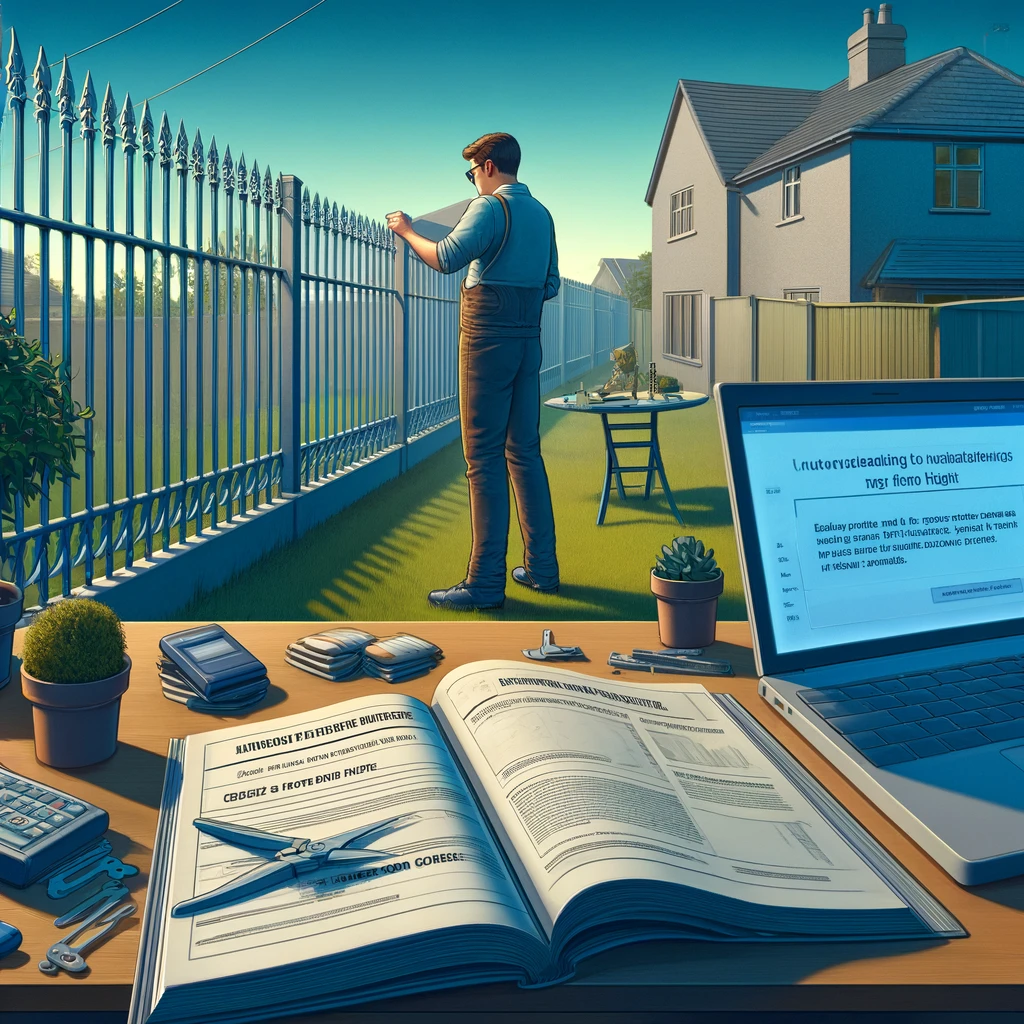
What Are The Benefits Of Metal Fences?
Metal fences offer numerous benefits, including durability, low maintenance requirements, enhanced security features, and the ability to provide privacy for residential and commercial properties.
Durability and Strength
The durability and strength of metal fences make them resilient against weather conditions, wear-and-tear, and potential intrusion attempts, ensuring long-lasting protection for properties.
Metal fences are renowned for their ability to stand the test of time, thanks to their robust construction and high-quality materials. Steel or wrought iron fences, for example, offer exceptional durability, capable of enduring harsh weather elements such as heavy rains, snow, or intense sunlight without corroding or weakening over time.
Their structural integrity provides a formidable barrier against physical impacts, offering reliable security for residential, commercial, or industrial properties. The sturdy nature of metal fences acts as a deterrent against unauthorized access, making them a popular choice for enhancing property boundaries and safeguarding assets.
Low Maintenance
Metal fences are known for their low maintenance requirements, with options like wrought iron and aluminium offering resistance to rust, corrosion, and the need for frequent upkeep.
Wrought iron, in particular, is lauded for its durability and timeless appeal, making it a popular choice for both residential and commercial properties. Its robust nature means it can withstand harsh weather conditions without succumbing to corrosion, ensuring that it stays looking elegant for years to come.
Similarly, aluminium’s innate resistance to rust makes it a practical and cost-effective option for those seeking a long-lasting fencing solution. This anti-corrosive property not only adds to the fence’s longevity but also reduces the necessity for regular maintenance, saving both time and money in the long run.
Versatility in Design
Metal fences offer versatility in design, allowing property owners to choose from various styles, ornamental features, and customisation options to match their aesthetic preferences.
From traditional picket fences to sleek modern designs, metal fences come in an array of styles to suit different architectural themes.
Adding ornamental details such as finials, scrolls, or lattice work can elevate the appearance of the fence, creating a statement piece for any property.
The flexibility for customisation allows for tailored solutions, whether it’s adjusting panel heights, incorporating decorative patterns, or choosing specific colors for a cohesive look.
Security and Privacy
Metal fences provide enhanced security and privacy for properties through sturdy gates, decorative elements, and options like aluminium fencing that offer both protection and aesthetic value.
These fences act as a physical barrier, deterring trespassers and enhancing the overall security of the property. The intricate ornamental details on metal fences not only add a touch of elegance but also serve as a strong visual deterrent. Privacy panels, strategically placed along the fence, ensure additional seclusion, blocking unwanted views and intrusions.
For instance, the selection of secure gates plays a crucial role in controlling access to the property. From traditional padlocked gates to modern digital access systems, homeowners have various options to choose from depending on their security needs and preferences.
Metal fences are often more expensive than other types of fences due to several factors:
1. Durability: Metal fences are known for their longevity and ability to withstand harsh weather conditions, making them a long-term investment.
2. Security: Metal fences provide a high level of security and are difficult to breach, which can increase their cost compared to other fence types.
3. Maintenance: While metal fences are durable, they may require less maintenance compared to other types of fences, which can contribute to their higher initial cost.
4. Aesthetics: Metal fences are often considered more visually appealing and can add a sophisticated look to a property, which can justify the higher cost for some individuals.
Overall, the higher cost of metal fences is often justified by their durability, security features, low maintenance requirements, and aesthetic appeal.
Metal fences are often more costly than other types of fencing due to their superior quality, durability, customisation options, and the additional security and aesthetic value they offer to properties.
Higher Quality and Durability
The higher quality and durability of metal fences, especially wrought iron and steel options, contribute to their elevated price point by ensuring long-lasting performance and structural integrity.
Wrought iron and steel are renowned for their resistance to wear and corrosion, making them ideal choices for fencing in various environments. Their robust nature allows them to withstand harsh weather conditions, such as heavy rain, snow, or intense sunlight, without compromising their integrity. This durability not only enhances their longevity but also reduces maintenance costs over time.
Customisation Options
Metal fences offer extensive customisation options, such as ornamental details, gate designs, and panel configurations, allowing property owners to tailor their fencing solutions to match specific aesthetic preferences.
In terms of design versatility, metal fences are a top choice for those looking to add a touch of elegance and individuality to their outdoor spaces. Ornamental features like scrollwork, finials, or decorative pickets can transform a simple fence into a statement piece that complements the overall style of a property.
The range of gate styles available for metal fences is vast and varied. From classic arched gates to modern sliding designs, there is an option to suit every taste and functional need. These gates not only provide security but also contribute to the overall look of the property.
Panel variations allow for further customisation, with options such as vertical slats, horizontal bars, or lattice patterns. This level of flexibility ensures that each fence can be tailored to blend seamlessly with the existing architecture or landscaping, creating a cohesive and harmonious appearance.
Installation Difficulty
The installation complexity of metal fences, especially steel options, can contribute to higher costs due to the skilled labour and specialised techniques required for proper assembly and structural integrity.
One major challenge when installing metal fences, particularly the steel variants, is the need for precision and expertise to ensure that each component fits securely and aligns correctly. This intricate process demands experienced professionals who understand the nuances of working with heavy materials and intricate designs to avoid structural weaknesses or safety hazards.
The complexity of metal fence installations can significantly impact project timelines and expenses. Delays may occur if there are difficulties in assembly, leading to additional labour costs and potential rework to rectify any errors. In addition, the specialised tools and equipment required for installing metal fences can also contribute to the overall project expenses.
Long-Term Savings
Despite initial higher costs, metal fences can offer long-term savings through reduced maintenance requirements, extended durability, and the added value they bring to properties like steel and aluminium fencing options.
Whilst the upfront investment in a metal fence may seem substantial, the long-term benefits far outweigh the initial expense. Metal fences, particularly steel and aluminium options, are known for their exceptional durability, capable of withstanding harsh weather conditions and resisting deterioration over time. This longevity translates to minimal repair and replacement costs, resulting in significant savings in the years to come. The low maintenance needs of metal fences make them a cost-effective choice, as they require less upkeep compared to other materials like wood or vinyl. The sturdy construction of metal fences not only ensures security and privacy but also enhances the aesthetic appeal and value of the property.
How To Save Money On Metal Fences?
Saving money on metal fences can be achieved through cost-effective material choices, DIY installation methods, and strategic planning when selecting panel configurations and design options.
One way to reduce costs is by choosing affordable materials such as steel or aluminium, which are not only durable but also cost-effective compared to traditional wrought iron. Opting for prefabricated panels can save on labour costs as they are easier to install, making it a feasible DIY project. It’s also advisable to compare prices from different suppliers to get the best deal. Consider staggering panel heights or utilising mixed materials for a unique yet budget-friendly design. By making informed decisions and planning ahead, you can create a beautiful metal fence without breaking the bank.

